Thursday, April 18, 2019
Thursday, April 11, 2019
How to Write a Blog Post in 2019: The Ultimate Guide

Here’s the thing:
There are many tutorials that can teach you how to write a blog post.
They can educate you on the mechanics of blogging, what to do, and what not to do.
Read them and you can learn how to craft a perfectly serviceable blog post. Heck, you might even write something that wins you an adoring fan or two.
But if you dream bigger, if you want to know how to write a blog post that cuts through the noise and wins you legions of fans, you need something better than a run-of-the-mill tutorial.
You need an ultimate guide.
In this post, this ultimate guide, we’ll share tips used by professional writers to create spellbinding posts that are adored by thousands. You’ll learn the secrets to crafting irresistible headlines, seducing introductions, captivating advice, and motivational closings.
You’ll even learn how the pros refine and polish their posts once they’re finished writing them.
These are secrets many bloggers would gladly pay real money to learn, but it won’t cost you a thing — other than a few minutes of your time.
Let’s dive in.
Step #1. Craft a Headline That Readers Can’t Resist
Want to know one of the biggest mistakes bloggers make?
Writing the blog post before the headline.
Without a headline, they have no roadmap to follow. And so their post goes in multiple directions, leaving readers feeling dizzy, confused and disoriented.
And then they try to create a headline that embraces all that madness. Bloggers, have mercy!
If you want to write a blog post full of clarity, conciseness and conviction, spend some time crafting a quality headline that sets a clear destination, lures readers in, and leaves them eager for your advice.
Your headline will be your map, your writing navigation system, letting you know which literary roads to choose and which to avoid so that readers reach the intended destination as easily and efficiently as possible.
Follow these 8 rules to craft your killer headline:
Headline Rule #1. Pick a Mouth-Watering Topic
Want your blog post to get opened?
Then your headline must promise readers the very answer to whatever is tormenting them. The thing that keeps them up at night.
Your headline should not promise them a trip to the moon and back — readers are way too swift for such shenanigans. Keep the benefit specific and narrow, and readers will feel compelled to click and get the solution to what’s bugging them.
How do you find out what’s bugging your readers? Research:
- Review comments on your posts and on posts of other sites in your niche.
- Send your subscribers surveys asking them what their greatest struggles are.
- Use tools like BuzzSumo to find out what the most popular posts in your niche are (which gives insight into your target readers’ needs).
- Read the reviews of books in your niche on Amazon (you’ll find a gold mine of feedback to explore).
You have one responsibility as a blogger — yup, just one. And that is to serve your audience. The better you know them, the better you serve.
Before you know it, you’ll know them so intimately they’ll feel like you’re reading their minds, and your headlines will reflect that.
Example:
Let’s say you’re in the self-improvement space and you wrote the headline below:
How to Create an Amazing Life
This headline is so broad it’s unlikely to draw readers in. No one loses sleep over “wanting to create an amazing life.” They lose sleep over specific aspects of their lives that have left them unfulfilled.
So you are better off narrowing in on something specific that’s bugging your readers, such as:
How to Boldly Pursue Your Dreams Even if You’re Scared and Insecure
Narrowing in on something specific makes readers feel like you have the answers they’re looking for.
Headline Rule #2. Steal from the Pros
Okay, you’ve done your research and you know exactly what your readers need. Now it’s time to turn your topic into into a killer headline.
The easiest way to master the art of writing headlines? Steal.
Not in the unethical way. In the smart and efficient way.
Decades of copywriting and advertising research have revealed the types of headlines that have proven to be successful. The types of headlines that zap readers out of their info-overload comas and compel them to open. Why mess with that research?
If you want your headlines to grab readers, stick with what works.
No, your headlines don’t need to sound like they came straight from BuzzFeed. They can reflect your voice and style.
But until you’re as skilled a writer as Jon Morrow, let the proven templates be your guide (how do you think he got so good at writing headlines?).
Blogging is hard enough, so if you have templates at your fingertips, why not use them?
The easiest templates to start with? “How to” headlines and list post headlines. They are classics and they work. In fact, 75% of Smart Blogger’s most popular posts use these formats.
Examples:
Here are a number of Smart Blogger headlines that follow the “how to” and list post templates.
“How to” Headlines:
- How to Start a Blog in 2019: Research Reveals 20X Faster Method
- How to Make Money Writing: 5 Ways to Get Paid to Write in 2019
- How to Make Money Blogging (Free Guide for 2019)
List Post Headlines:
- 21 Dumb Mistakes to Avoid When Writing Your First E-book
- The 5 Best Free Blogging Platforms in 2019 (100% Unbiased)
- Writer’s Block: 27 Ways to Overcome It Forever
Headline Rule #3. Engage Your Senses
Vague headlines leave readers feeling empty. Tangible headlines leave them feeling understood.
How to you create tangible headlines? Put yourself in the shoes of your reader.
How do they feel? What do they see, taste, or smell? What do they hear?
Engage all of your senses. The more your headline gives voice to their exact experience, the more they’ll feel like your post was written for them.
Example:
Let’s say you blog about health and wellness and you wrote a headline called:
5 Steps to Take When a Migraine Hits
This headline follows a proven list post formula, and it narrows in on something that’s bugging readers. All in all it’s not too bad, but it could be even more concrete.
To step it up a notch, put yourselves in the shoes of your readers. Think about exactly what they’re experiencing.
Perhaps that would lead you to the following:
5 Ways to Soothe Pounding and Blinding Migraines
If you suffer from migraines, there’s no way you could resist clicking such a headline.
Headline Rule #4. Tease, Don’t Satisfy
A common mistake you may not even realize you’re making?
Giving away too much in your headlines.
Your headlines should lure readers in like a literary temptress. They should catch readers’ attention and invoke their curiosity, not give a solution.
Give a solution in your headline and readers feel no need to go any further — they’re bored by the very thought of your post.
When this happens, not only do you lose but your readers lose as well, as they trade the richness of your post’s advice for the quick fix offered by the headline.
Example:
Let’s say you blog about personal finance and you write the headline below:
How to Save for Retirement by Creating a Monthly Budget
Sadly, readers will see this and think they’ve got all the advice they need — if they want to save for retirement, they must create a monthly budget. No need to read more.
On the other hand, a possible revision could be:
How to Save for Retirement When You’re Living Paycheck to Paycheck
For anyone living paycheck to paycheck, this headline would pique their curiosity. Nothing is given away, it speaks to an audience with a very specific problem, and it promises a solution they’d love to get their hands on.
Headline Rule #5. Honor the Headline Commandment
When it comes to headlines, there is only one commandment you can never break:
“Thou shalt not deceive.”
This may seem obvious, but writers inadvertently do it all the time. How?
They over-promise.
Big no-no. The content of your post must fully deliver on exactly what the headline promises.
If the post only delivers part of the solution, readers will feel misled and lose their trust in you.
Let’s never do that to them, yes?
Examples:
Let’s say you write a post called:
How to Live a Happy and Peaceful Life
But then the post only talks about following your dreams, which is really only one aspect of living a happy and peaceful life. Even though you didn’t intentionally deceive them, readers will feel shortchanged.
Another example — perhaps you write a post called:
5 Killer Ways to Attract New Clients to Your Coaching Business
But then the fifth way contains no useful advice and instead leads to a sales page to get the solution … no bueno.
Headline Rule #6. Trim the Fat
Want to overwhelm readers right from the start?
Fill your headline with weak and flabby words.
What are weak and flabby words? Empty, unnecessary words that add no real value. Instead, they create clunky phrasing and leave readers scratching their heads in confusion.
The mistake many bloggers make is writing headlines the way they speak. While that’s okay when you write the post (to a certain extent), when you write headlines that way it waters them down.
You want your headlines to be as ruthlessly concise and powerful as possible. So chop out weak words and throw in power words (if appropriate).
Examples:
Let’s say you draft the following headline:
How to Find It In Your Heart to Forgive Someone Even if They’ve Hurt You Really Badly
There are just so many words! We can cut them down as follows:
How to Forgive Someone Who Hurt You Badly
We can then add some power to it:
How to Forgive a Soul-Crushing Betrayal
Much better.
Another Example:
Here’s a mouthful:
How to Stop Being Overly Doubtful of Yourself So You Can Finally Begin to Pursue Your Wildest Dreams
My head is spinning. This can be cut down to:
How to Stop Doubting Yourself and Pursue Your Wildest Dreams
We could even make it more tangible and powerful:
How to End Paralyzing Doubts and Conquer Your Wildest Dreams
Nice and trim, but packs a punch.
Headline Rule #7. Don’t Be a Smarty-Pants
Your headline should make sense to all readers no matter where they’re coming from or in what context they’re approaching your post.
They shouldn’t have to guess what the benefit is. After all, you’re supposed to be reading their minds, not the other way around.
So you’ll want to avoid using metaphors (unless their meaning is painfully obvious), jargon, rhymes, made-up terms, or anything that tries to be overly clever or complicated when drafting your headlines.
Examples:
Where to begin with this one:
How to Be Happy Without Acting Sappy
A headline like this tries to be too clever — readers don’t give two hoots about not acting sappy, obviously. Don’t prioritize cute tactics like rhyming over delivering clear benefits in your headlines.
How to Raise a Child That Is the Apple of Your Eye
A headline like this is also trying to be too clever. “Apple of Your Eye” is a common metaphor readers are likely familiar with, but there’s no concrete benefit being offered here. A headline must always contain a strong benefit, not a cute phrase.
How to Follow the Path of Glory to Your Success
No clue what this means … and I just wrote it. If there isn’t a singular and clear interpretation of what the headline’s benefit is, it’s trying too hard. So save the metaphors for the actual post where they will (hopefully) make more sense.
How to Stop Treating Love Like a Captive Animal
Perhaps you effectively explain in the post how people treat love like a captive animal, and it may make for a great analogy, but readers scanning headlines will have no clue why they should stop to read this, and so they likely won’t.
Headline Rule #8. Rock Your Style
The more consistent you are with your audience, the more trust they’ll feel for you.
If you generally keep your headlines pretty simple and then suddenly write one jam-packed with power words, your readers will feel confused.
The more you write, the more of a style you’ll develop. Once you determine what that style is, use it consistently (or make slow and gradual changes to it if necessary) so your audience learns and trusts your brand.
Example:
If most of your headlines read like this:
- How to Live With Courage
- How to Overcome Social Anxiety
- How to Confidently Embrace Uncertainty
Then you might not want to suddenly write a headline that reads:
- How to Brazenly Squash the Agonizing Anxiety That Is Plaguing Your Life
Your readers will think your blog got hacked!
How to Write a Headline: Bonus Tip
When writing a headline, try crafting 5–10 different versions of the same headline.
The more you play with the words, the better you will get at creating clear, concise and curiosity-invoking headlines that readers cannot resist.
Editor’s Note:
I’d be remiss if I didn’t discuss a question we hear often:
“How long/short should my headline be?”
Ever notice how some headlines in SERPs (search engine results pages) are truncated?
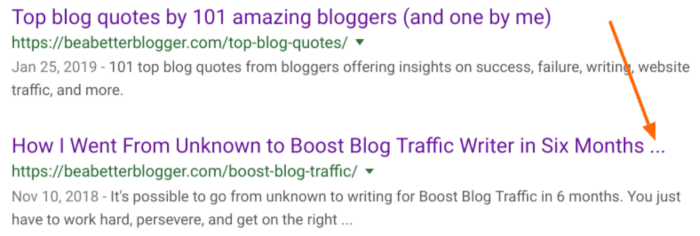
It’s based on your headline’s width in pixels, but as a general rule: right round 60 characters Google will cut off your headline.
Since a truncated headline can result in fewer people clicking your link in SERPs, it’s a common SEO practice to keep your headlines 60 characters or less.
Of course, things are never that easy.
In a recent study, Brian Dean of Backlinko found that longer (14-17 words) headlines generated more shares on social media than shorter headlines.
(76.7% more social shares, to be exact.)
As with all things, your mileage may vary.
Step #2. Write an Introduction That Grabs and Seduces
You’ve lured readers in with your headline. Now you’ve got to keep them.
No easy task, my friend.
Readers are fickle. Known to take a quick glance and then vanish from your online sanctuary, lickety-split!
You must fight to keep them there, and the way you craft your introduction plays a huge role in their browsing commitment.
Follow these rules to craft an introduction that captivates your readers:
Introduction Rule #1. Slip into Their Shoes
A common mistake that reeks of amateur blogging?
Trying to sound too academic in your blog openings.
You know, those posts that start like this:
“Research has proven that 92% of people fail to achieve their goals because they are unable to create and stick to habits that support those goals …”
Don’t get me wrong — as a lawyer, I value solid research. But in the blogging context, this approach bores readers. If you want to captivate instead of bore, you must make readers feel like you’re reading their minds.
A powerful way to achieve this?
Empathy.
Step into their shoes and write from their perspective. Show them you understand exactly what they’re going through.
After all, you likely struggled with the very topic you’re writing about and learned how to overcome it. We teach what we most wanted to learn, right?
So show readers that you “get it.” You’re not some corporate slog, you’re in it with them, fighting the good fight and sharing the tools that brought you to the other side.
Example:
This introduction is a masterclass in empathy:
Do you feel that?
That little tugging sensation on your heart?
You’re not sure what, but something is pulling you to change. Not in a confess-your-sins-oh-ye-sinners way, but to shift directions, to embrace your calling, to finally do what you were put here to do:
Write.
You feel the ideas inside you. You sense them straining to escape. You know your job is to set them free, firing them like a cannon into a world in desperate need of them.
But you’re afraid.
You’re afraid of quitting your job and living without a safety net. You’re afraid of the concerned, disapproving looks your friends will give you when you tell them you’re giving it all up to write for a living. You’re afraid of not having enough money for food, of the power being cut off, of watching your family shivering and hungry, all because of your “selfishness”.
And most of all?
You’re afraid you’re wrong about yourself.
As writers, we all share the deep longing to embrace our calling and express our ideas, but we also share the fears that so often sabotage those longings — the fear that we don’t have what it takes, that we’ll crash and burn, and that our dreams are just that — dreams.
In his introduction, Jon addresses all those longings and fears and immediately makes you feel like he gets you so intimately, it’s almost creepy.
Creepy, but effective.
Introduction Rule #2. Get into Character
If you want to captivate readers, you must trigger their emotions.
So as you sit down to write, think of the feelings you want them to experience:
Fear, anger, sadness, hope, joy, disgust, shame, comfort, love, courage, and so on.
Then get into character and feel them yourself as you write, and your words will read with undeniable authenticity.
When Lin-Manuel Miranda wrote the heartbreaking lyrics in Hamilton that have left tears on the faces of millions, it was his eyes that first shed tears as he put his pen to paper.
So play with your emotions. Map out the emotional journey you’re taking readers on, and infuse those feelings into your writing. Feel what you want your audience to feel and your words will exude those emotions.
This tip applies to your whole post, but in no place is triggering your audience’s emotions more important than your introduction.
You feel me? 🙂
Example:
I once wrote an emotional post about my two little girls which addressed how delicate their emotions are, as well as my own vulnerabilities and my longing to give them the patience, presence and love they deserve.
Here’s a portion of it:
I told my three-year old daughter as we stood outside the car in her school parking lot, the rain pouring down on us as she sobbed breathlessly in my arms.
She didn’t want to go in the car. She just wanted me to stand there, holding her. And I didn’t want to rush her, or tell her to stop crying.
“I’ll hold you for as long as it takes.”
I felt that longing intensely and definitely shed some tears as I wrote the introduction. The feedback I got from readers was that they felt the same intensity, and even cried as well.
When we write, our feelings seep into our words.
Introduction Rule #3. Lure Readers Down the Page
Want readers to commit to your post?
Accelerate their experience. Lure them down the page.
The faster they get pulled down, the more committed they’ll feel.
Too many bumps in the road early on, and off track they go, never to return.
Here are three copywriting tips to use in your intros to lure readers down the page:
#1. Open With a Short Sentence or Question
Kind of like how I opened this section. 🙂
This is how all of Smart Blogger’s posts open, and for good reason. It’s a copywriting technique proven to pull readers in.
Start a post with a long clunky paragraph and they’ll feel exhausted just looking at it.
#2. Take a Knife to Your Words
Slash as many words as possible.
If the first draft of your introduction is 200 words, try cutting it down to 100. The more you practice this, the more efficient your writing becomes.
And when you write efficiently, your words have power. That power will grab your readers.
#3. Set the Rhythm
All writing has a pace and rhythm.
You want your introduction’s pace and beat to be somewhat quick. You can slow things down later.
How do you achieve this?
- Use short sentences. Even sentence fragments (totally okay).
- Make your paragraphs no more than one to three sentences long.
- Use delayed transitions to weave sentences together.
- Make each sentence and paragraph lure readers into the one that follows.
- Read the post out loud to check the flow. Are things moving forward smoothly or stalling?
The best writers, like the best music composers, take readers on a journey. Fast and slow, loud and soft, urgency and ease.
The more you pay attention to this, the more rhythm you’ll infuse into your words.
Example:
Shane Arthur sends readers’ eyes flying down the page by using crisp sentences and short paragraphs to create a fast rhythm:
You’re not stupid.
You know what writing is truly about.
It’s a never-ending battle for your readers’ attention.
Every sentence is a link in a taut chain that connects your headline to your conclusion.
And you are just one weak sentence away from losing your reader forever.
He then appropriately slows things down in the section that follows with longer sentences. A masterful composition!
Introduction Rule #4. Make Them Beg
Want readers begging for your solutions?
Add a little fear to your opening.
What are readers worried about? Do they know what will happen if they don’t solve the problem the post is addressing? What is the worst-case scenario?
Bring those fears to the surface. Expose them.
By doing so, not only will readers feel a camaraderie with you (because you understand their fears, so clearly you’ve tip-toed through the dark side yourself), but they’ll feel more eager than ever for the solution you present.
We all have fears. We think we need to hide them, but the more we give voice to them, the easier they are to set free.
Do that for your readers.
Example:
In his introduction, Glen Long brilliantly taps into the fear of failure all writers experience by addressing the dream of making a living as a writer and then quickly smothering that dream with the doubts that creep up at the mere thought of it:
So, who knows? Maybe the doubters are right. Maybe you are naive to think you could earn a living doing something you love, instead of something you just tolerate.
The fear of failure is painful, yes. But giving voice to it is validating and makes readers eager for the solutions that will set that fear free.
Introduction Rule #5. Hint at the Promised Land
Finally, as you wrap up your intro, hint at the promised land.
The place readers will get to when they master your methods. The destination your post promises to take them.
But whatever you do, do not give it all away. Just one sentence that says too much satisfies your readers enough to send them clicking away.
Why? Because readers bore easily. You must keep them on their toes. And the point of an introduction is not to give answers, it’s to set the stage for all the hearty advice your post will provide.
Example:
In the introduction to Meera Kothand’s post, she addressed a problem all new bloggers face: How do you get to know your audience when you don’t have one yet?
She goes on to talk about the big mistake many of them make (making assumptions) and why that’s ineffective. Then, she uses the simplest phrase to hint at a solution:
That kind of guessing is like throwing darts blindfolded and hoping you hit the bull’s eye.
Sometimes it works. Usually, it doesn’t.
Fortunately, there’s another way…
How could anyone not want to keep reading?
How to Write an Introduction: Bonus Tip
When writing an introduction, try drafting two completely different versions approached from different angles and triggering different emotions.
Doing so will highlight the techniques and emotions that work best for both your audience and the content of your post.
Editor’s Note:
A word of caution:
No matter how eloquent your words…
No matter how powerful your prose…
If your introduction doesn’t satisfy user intent, readers will click the “back” button and never return.
What’s user intent?
It’s the purpose behind the Google search.
If someone searches for “how to lose weight” in Google, they’re expecting search results that will help them lose weight.
If they click a headline that reads “7 Easy Tips For Losing Weight Fast”, and the post begins with an amusing Nicolas Cage anecdote, there’s a good chance they will leave — never getting to read the rest of the post, which is filled with weight loss wisdom.
And when they leave, what they’re essentially telling Google is this:
“At no point in your rambling, incoherent response were you even close to anything that could be considered a rational thought. Everyone in this room is now dumber for having listened to it. I award you no points, and may God have mercy on your soul.”
And Google will respond by ranking your post lower in its search results.
Step #3. Deliver Advice That’s Easy to Consume and Impossible to Ignore
Okay, you’re doing great.
You got readers to click on your headline, you lured them down the page with your intro, and now it’s time to deliver on all that you’ve promised.
If you want readers to love you and look forward to every post you write, you’ll over-deliver.
If you want them to take a quick look and vanish for good, you’ll under-deliver.
The choice is yours.
Use the guide below to deliver valuable and easy-to-consume advice:
Content Rule #1. Add Pitstops
Subheads — use them.
Why? Because readers are scanners.
They have no choice. There’s a behemoth amount of content at their fingertips, and not all of it is good.
And so they scan (as do you, I’m sure).
Subheads are your chance to prove to readers that your content holds value. To keep luring them back into your post, when their instinct is to leave.
Blogging is a battle, remember?
Keep these four tips in mind when drafting your subheads:
#1. Add a Subhead Every Few Paragraphs
Sprinkle subheads throughout your post.
Why? Because they gently guide readers along the route your post is heading, making their experience feel clear, easy and enjoyable.
And never forget, your blog posts are all about your readers’ experience.
If readers see too much text when they’re scanning without enough pit stops, they’ll feel overwhelmed. It’s like getting on a bus tour and being told there will be no bathroom breaks … oh, the anxiety!
Example:
Every single post on Smart Blogger.
Seriously.
That’s how important this is.
#2. Avoid the 3 Subhead Blunders That Make Readers Bounce
Subheads have the same function as headlines; they must make readers curious so they keep reading. So you should follow similar rules when drafting them and avoid the following common blunders:
- The Plain Label Subhead: In case it bears repeating, never bore your readers. Labels are boring. Treat your subheads like mini-headlines and make sure they invoke curiosity.
- The Spoiler Subhead: Don’t give away too much in your subhead. If you do, readers will feel no compulsion to read the rest of your text.
- The Cryptic Subhead: Don’t try to be too clever. Readers don’t like to play guessing games. Adding curiosity should never come at the expense of clarity.
Example:
Let’s say you’re writing a post about the impact sleep has on anxiety levels and you include the following subheads:
- The Importance of Sleep
- Creating a Steady Sleeping Routine Will Reduce Anxiety
- Refuse the Roast and Catch More Z’s
See how the first subhead is way too plain, the second gives too much away, and the third, well, it probably made no sense to you, right?
The subheads below would do a better job at grabbing readers:
- The Easiest Way to Reduce Daily Anxiety
- How to Beat Anxiety Without Resorting to Medication
- The One Thing You Must Avoid to Sleep Better
#3. Compare Each Subhead to Your Main Headline
Each subhead should clearly deliver on the overall headline of your post.
Again, if you’re viewing subheads as pit stops, they must all lead to the ultimate destination — what was promised by your headline.
If the subheads get off track and move away from that destination, readers are left feeling lost and confused.
In that case, either the subheads need to change or the headline needs rethinking.
Example:
Say you’re writing a post called “How to Silence Your Nagging Inner Critic” and you include the following subheads:
- Observe Your Thoughts
- Prove Yourself Wrong
- Ask Yourself This Powerful Question
- Bravely Quit Your Day Job
The fourth subhead’s sudden twist in topic is jarring. It does not deliver on the overall headline, which had nothing to do with your day job.
Perhaps you intended all along for the post to be about not letting doubts stop you from following your dreams and quitting your day job, but readers scanning subheads will not understand that.
They will simply feel confused.
#4. Follow a Format
If you are listing various “ways,” “steps,” “methods,” “signs,” etc., to achieve what the headline of the post promises, keep the format consistent.
If you don’t, the post comes across as unpolished. Bloggers overlook this all the time, but it’s easy to fix once you’re aware of it.
If you separate your subheads from the post and list them back to back, you can see if any stray from the course.
Example:
Say your post is called “12 Ways to Cure Insomnia” and you have a subhead for each of the 12 ways. You’ll want those subheads to follow a consistent format.
Let’s say your first few subheads read as follows:
- Exercise Every Morning
- Avoid Caffeine Like the Plague
- Wake Up at the Same Time Everyday
- There is Nothing More Sleep-Inducing Than Nighttime Meditation
Something there feel a little off?
The first three subheads start with an action verb instructing readers what to do. They are also fairly consistent in length.
But then the fourth subhead suddenly changes the format and breaks the flow. It doesn’t start with a verb and it’s much longer than the others.
This inconsistency may seem fairly innocent, but it’s distracting to readers.
Content Rule #2. Unleash the Unexpected
Let’s face it, readers today are info-holics. We all are.
So tired old advice isn’t going to cut it. Your post must be unique, bold, and eye-opening.
My advice? List your main points and see if you can add a unique perspective, experience, or twist to them. Something readers aren’t expecting.
What belief systems have you learned to challenge? What do you know that most people don’t? How can you shed new light on an old problem? What methods do you use that others won’t know about?
You don’t want to go overboard just for the sake of adding shock value. Your advice must be authentic and truly helpful. But regurgitating old advice doesn’t challenge you as a writer, nor does it enlighten your audience.
So pour your readers a little espresso for their info-hangover by delivering the unexpected.
Example:
Countless articles have been written about blogging, but how many have called you out for being dumb or told you to replace your friends?!
Jon does just that by knocking you over the head with some hard truth bombs about what it takes to make it as a blogger.
Content Rule #3. Follow a Formula
Notice how this post follows a pretty consistent formula?
Each section is relatively similar in length. Every subhead follows a pattern. Each section ends with an example.
The more consistency you weave into your posts, the better the reader’s experience.
Let’s say you write a list post covering five steps to achieve something. If the first step is 500 words, the second and third steps are 100 words, the fourth step is 200 words and the fifth step is 400 words, it looks sloppy. As though you didn’t bother to edit it before hitting publish.
Your readers deserve the best, and minor details like this matter as they affect the fluidity of their experience.
Want to go even more pro? Look at the the beginning, middle and end of each section you write, and create a guiding formula. Perhaps you start each section with a bold statement or personal experience. Then you flesh out your advice in the middle. And then you end each section with a one-sentence call to action.
The more formulas you add to your posts, the easier they are to write and the more they look like polished works of art.
Example:
In his post on getting traffic from Twitter, Brian Honigman uses hashtags for each subhead, each section is consistent in length, and each includes a graphic.
Readers know exactly what to expect from each section, making for a fluid reading experience.
Content Rule #4. Be Ridiculously Generous
Many bloggers worry about giving away too much in their posts. After all, they want readers to sign up for their paid coaching calls or products.
So they hold back, barely skimming the surface of their advice.
Truthfully, if you’re not generous with your readers in your posts, they won’t get a good impression of your paid products.
Don’t hold back on your readers. Fully work through the problem with them. Give them complete solutions and powerful advice. Wow them with your generosity and they will stick around as loyal readers and customers.
Example:
Want to learn everything there is to know about affiliate marketing?
Holy smokes. At 10,000 words, that insanely generous post by Leanne Regalla is basically a textbook on the subject, and reader comments praise it as such. (Let’s all bookmark this one, yes?)
A post of this magnitude is quite an undertaking, but don’t let it scare you. You can also wow your audience with your generosity and thoughtfulness in a 1,000-word post.
Content Rule #5. Start and End Strong
Just as your introduction and conclusion should grab readers, you want the main body of your post to start and end strong as well.
Of course, every section should have valuable content, but if you’re offering five ways to achieve something, save your absolute best tips for the first and fifth ways. The first way will grab your readers’ attention, and the fifth way will leave them feeling fully satisfied.
On the other hand, if each tip successively decreases in value, readers will feel like your post is deflating. And their excitement will deflate with it.
Let’s leave readers feeling pumped when they finish your post.
Example:
Linda Formichelli gives ten crafty ways to write 1,000 words per hour.
While all ten ways are excellent, I’d argue that the first (about writing under the pressure of a full bladder) and last (about gambling with your reputation) are the most bold and attention-grabbing (bathroom break, anyone?).
Writing a Blog Post: Bonus Tip
Before writing the main sections of your post, flesh out an outline to nail your points down.
The clearer and more simplified your outline is, the more clarity and conviction your post will have.
Step #4. Close with a Motivational Bang
We’re almost at the finish line! It’s time to close your post with a bang.
This is where you rally behind your readers. Show them that you believe in them.
Make them believe they can achieve the goal promised by your headline (because after reading your generous advice, they certainly can).
Follow these rules when crafting your motivational conclusion:
Conclusion Rule #1. Give Your Readers a Pep Talk
Motivate your readers.
Show them how far they’ve come, what they’re capable of, and what life will look like once they’ve implemented your advice.
Give them the pep talk you longed for when you were struggling with the topic your post presents.
Empower them by raising your expectations of them. They can’t just read your post and pretend it never happened — they must take action. Immediately.
Make them see that no matter what they’ve experienced or how hard they’ve struggled, their time is now.
Example:
In this post’s conclusion, Jon uses all he’s had to overcome in life to show readers that they have no excuses: no matter hard things get, they can accomplish anything they set their minds to.
He encourages readers by letting them know that he believes in them and then he raises his expectations of them by telling them they need to get started … “right freaking now.”
By the time you’re done reading the conclusion, you feel like you can conquer just about anything!
Conclusion Rule #2. Avoid New Information
A common mistake many bloggers make?
Suddenly inserting new information or tips in their conclusions.
It’s like reaching the last ten minutes of a spellbinding movie. You’re on pins and needles waiting to see how it ends, and suddenly a new character is introduced. What the … ?!
It’s jarring. Don’t do that to your readers.
Example:
In his conclusion, Robert van Tongeren motivates you to repurpose old blog posts by comparing them to epic musical classics; if they disappeared into obscurity simply because they’re old, we’d all be at a great loss.
Imagine if in the midst of such a conclusion, Robert quickly threw in one more way to repurpose content, or one small caveat to his post’s advice, or one more general tip to keep in mind?
It would throw the whole closing off and leave readers feeling ruffled instead of jamming to Bohemian Rhapsody.
How to Write a Conclusion: Bonus Tip
When writing your conclusion, put yourself back in the shoes of your readers.
What will their lives be like if they accomplish the advice in your post? How will they feel?
The more you can hone in on your readers’ point of view, the more you can motivate them to take action.
Editor’s Note:
Too many bloggers put too little thought into their closings.
That’s a shame.
Let’s face it…
Most people don’t read 100% of our posts. Heck, most people don’t even read half.
So how do we reward the precious few who read and absorbed the words we poured our heart and soul into?
With a closing we whipped together in 20 seconds.
Someone who makes it to the end of your post is primed.
They trust you. They like you. They want you to tell them what to do next.
So tell them.
Don’t waste this opportunity.
Step #5. Polish Your Post So It’s Smoother Than a Slip ‘n Slide
Phew! You’ve written your post. Next up?
Take a well-deserved break. Step away for a day or more so you can come back to it with fresh eyes.
Once you’re ready, it’s time to do some editing. I know, the mind reels that there’s more work to do!
But editing your post is essential. If your post doesn’t provide a smooth reading experience, your reader will lose attention and bail.
Use this checklist when you’re ready to edit your post:
- Take a Knife to It. Slash all unnecessary words, sentences, paragraphs, stories, etc. Include only what is absolutely essential to convey your message. Nothing more.
- Motivate, Don’t Lecture. Tweak any statements that hint of being the condescending professor. Make readers feel like you’re on their side and dedicated to their success (because you are).
- Add Emotion. Infuse your writing with passion, energy, and enthusiasm. If you’re bored by your topic, readers will be too.
- Make it Easy on the Eye. Break up any large paragraphs (2–5 sentences maximum is your goal) and run-on sentences.
- Break it Down. Clarify overly complicated wording. If you can’t say it simply, don’t write it. You don’t want to confuse your readers.
- Speak Their Language. Add examples or metaphors to make complex ideas feel more tangible and easier to digest.
- Check Yourself. Remove any contradictory statements or repetitive ideas (trust me, they’re there).
- Don’t Yo-Yo. Ensure each sentence, paragraph and section drives the post forward toward the destination promised by the headline (no side routes or backtracking).
- Be Smooth. Make each sentence and paragraph flow seamlessly into the next. Each sentence should be completely dependent on the ones before and after it or the transitions will feel choppy.
- Avoid Sharp Turns. Adjust any abrupt changes in topic. They’re jarring to readers.
- Keep It Real. Don’t mimic styles that don’t come naturally to you. The more you write, the more you’ll find your authentic writing voice.
- Add Highlights. Use bold and italics to add stress where appropriate (but do so sparingly).
- Shoot Bullets. Use bullet points to group related ideas and make them more digestible.
- Spark the Senses. Be specific and concrete (describe things readers can see, feel, hear, smell or taste). Avoid abstract statements.
- Be Firm. Avoid words like “might,” “may,” “possibly” and “perhaps” when delivering your advice.
- Respect Nature. Put things in their natural order (e.g., past to present, young to old, small to large, breakfast to dinner, etc.).
- Be Consistent. Make sure all points in a list belong to the same category; a list of steps should only list steps, a list of things should only list things, etc. This might sound like common sense, but this rule gets broken often.
- Don’t Be Lazy. Ensure all the necessary information is contained within the post itself. (External links should only provide supplemental information. A reader shouldn’t have to click a link to comprehend your post.)
- Kill the Weak. Eliminate weak and flabby words. Replace weak verbs (e.g., “she went”) with more concrete, visceral verbs (“she walked”), replace passive voice (e.g., “he was pushing”) with active voice (e.g., “he pushed”) and replace weak adjectives (e.g., “good”) with strong adjectives (e.g., “wonderful”).
- Feel the Beat. Be mindful of the pace and rhythm of each section. Speed things up or add some punch with crisp, short sentences. Slow things down with longer explanations. Good writing uses both.
- Do the Obvious. Fix any spelling or grammar mistakes (check out tools like Grammarly and Hemingway App).
- Be Honest. Give credit where due.
How to Edit a Blog Post: Bonus Tip
A great way to self-edit your posts is to read them out loud.
Doing so will help you catch many of the issues listed above, particularly things like overly complicated wording, run-on sentences and choppy rhythm.
Win the Battle for Your Reader’s Attention
Blogging is a battle.
A war to get your ideas the attention they deserve.
Your enemy? The dizzying array of online distractions that devour your readers.
This battle is not for the faint of heart.
There are so many learning curves. Blogging platforms and plugins you’ll need to install. Social networks you’ll need to employ. Marketing techniques you’ll need to try.
But none of that stuff matters if you’re drowning your ideas in amateur writing. You might as well lay your sword down in defeat. Readers don’t have time for amateurs.
So before you venture any further down the blogging rabbit hole, you better make sure you know how to write a blog post like a pro.
Skip that step, and nothing can save you. Your battle is lost.
The good news is, writing effective blog posts is a skill you can learn. And it’s one you must learn.
You have powerful words and ideas that can transform readers’ lives. Those ideas are worth fighting for.
So when you’re ready to enter the arena, arm yourself with this ultimate guide and fight the good fight.
Your readers are counting on you.
The post How to Write a Blog Post in 2019: The Ultimate Guide appeared first on Smart Blogger.
from
https://smartblogger.com/how-to-write-a-blog-post/
Thursday, April 4, 2019
How to Promote Your Blog in 2019: 9 Creative Strategies

Whether your blog is brand new or already established, you can never have enough traffic.
Seriously…
I work at an SaaS company called Ahrefs, and even though the Ahrefs blog pulls in over 200k organic traffic every month, we still experiment with ways to promote our blog and bring in more traffic.
Because let’s face it:
It’s 2019. Simply sending an email blast to your subscriber list doesn’t cut it anymore.
But don’t fret.
If you’re stuck coming up with new ideas for how to promote your blog, here are 9 tried-and-tested tactics that have worked for us.
Let’s dig in.
#1. Work with Podcasts
Let’s start things off with the buzzword of the year: podcasts.
Thanks to their flexibility (you can listen to them while you’re at work or when you’re on the go), they’re the most popular form of audio content.
They’re also widely available on services like iTunes, Google Play, and Spotify.
Some quick facts:
- Over 44% of the US population has listened to a podcast;
- They’re extremely targeted, with multiple podcasts covering every niche imaginable;
- Their audiences are incredibly engaged.
Ahrefs has had great success with sponsoring podcasts (paid advertising) as well as guesting on them — that is, sending a member of our team to be interviewed on a show.
Here’s an actual comment from a new customer and blog reader of ours:

For sponsoring podcasts, think of this tactic as a type of influencer marketing.
Your job is to sell your blog to the podcast host and the podcast host’s job is, in turn, to sell your blog to their audience.
How to Promote Your Blog by Sponsoring Podcasts
If you have the budget, sponsoring podcasts is a great way to promote your blog. Here’s how you do it:
Step #1. Do Your Research
Create a list of podcasts whose audiences are a good match for your blog. If you have no idea where to start, here’s a tip:
Try using a specialized podcast search engine like Listen Notes. Browse the shows and pick your favorites.
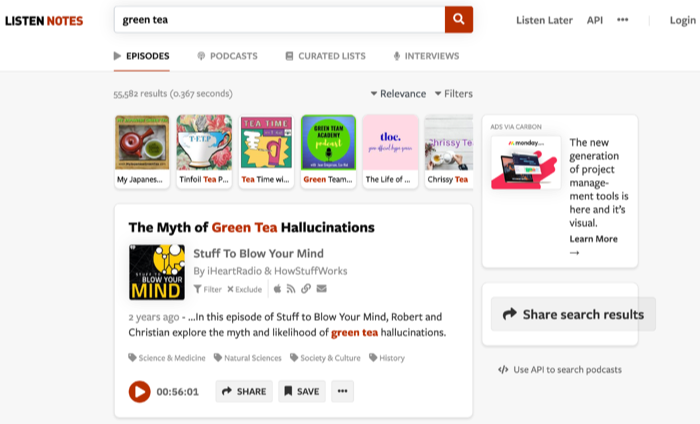
Step #2. Make Contact
Once you’ve created a list of targets, you’ll need to contact the podcasts and inquire about sponsorship details.
What are their pricing packages? What dates do they have available? Are there any gotchas?
Prices can range from $50 to $5,000 and beyond per episode, so work within your particular budget.
Step #3. Iron Out the Details
This includes your ad copy, delivery, and any other deliverables like your blog’s logo and elevator pitch.
In my experience, organic reads do much better than “scripted ads.”
The goal is to get the podcast host to sound like a fan and regular reader of your blog.
Step #4. Wait for Your Ad to Air
If anything is off, be sure to let the podcast know as soon as possible!
How to Promote Your Blog with Podcast Interviews
If you’re strapped for cash (or simply don’t want to do podcast advertising), another approach is to appear as a guest on podcasts.
This is usually free — unless you’re approaching extremely-popular podcasts, which tend to charge a one-time appearance fee.
The catch is you’ll need some kind of credibility to your name. In other words, you’ll need to convince the podcast host that you’re someone their audience would love to listen to.
The process for this is similar to the one detailed above:
Step #1. Create a Target List
Use Listen Notes or a similar tool to create a list of podcast targets.
Step #2. Check if They Accept Interviews
Often, podcasts will explicitly state on their websites whether or not they accept interview requests.
And if they don’t accept interview requests? Ask anyway.
Send in your pitch and convince them you have lots of value to add.
Step #3. Follow the Host’s Lead
Every podcast will have their own process. Some may want to do pre-interviews, some may want to work on a rough content online with you, and some may want to just “wing it.”
Whatever the process, remember to be courteous and respectful — you’re a guest, after all.
Just don’t forget to mention your blog!
Editor’s Note:
Appearing on podcasts is one of our favorite promotion strategies here at Smart Blogger — as evidenced by our appearances on EOFire, James Altucher, Duct Tape Marketing, the Write Podcast, and Loz James’ Content Champion.
Just make sure you’re prepared:
- Show up early to the interview so the host has time to do a sound check.
- Don’t use your phone or your laptop’s built-in microphone; instead, invest in an external microphone. Quality and price points vary, but you can get a simple microphone that plugs into your computer’s headphone jack for the price of a medium pizza.
- Use headphones to cut down on echoes.
- Turn off all notifications and, if you can, shut your door to minimize background noise.
#2. Republishing on Medium
Sure, you can publish tons of absolutely amazing posts on your own blog.
But if you never extend your reach, whether it’s by growing your list of email subscribers or boosting your number of social media followers, your audience will be limited.
So what do you do if you don’t have time to create promotional content and extend your reach?
Try this:
Republish your existing posts on blogging platforms like Medium.
Your content will be seen by a whole new audience — some of which will then visit your blog and discover all the great content you have to offer.
For example, look at this blog post I published on the Ahrefs blog last December:

It got 463 shares and 43 comments — very decent engagement considering the fact that the topic likely didn’t appeal to our blog’s core audience (people interested in search engine optimization).
In a bid to push the post out to a wider audience, we republished it on Medium. It turned out to be a fantastic decision.
Here are the stats as of March this year:
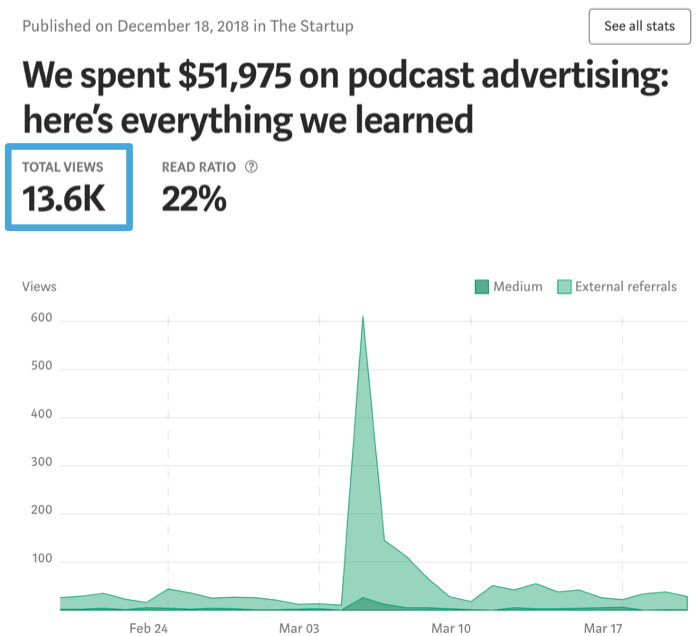
That’s 13.6k views in total, with 22% of readers actually finishing the whole post.
Plus, the Medium publication of this post averages a steady trickle of 10-30 readers every day.
How to Republish on Medium
Medium has made the process of importing and republishing content super simple. Here’s how you do it:
Step #1. Choose a Post to Republish
Ideally, pick one of your top performers (since it’s already proved it’s popular).
You can use a tool like Ahrefs’ Top Content report in Site Explorer to see which of your posts have the most shares on social media.
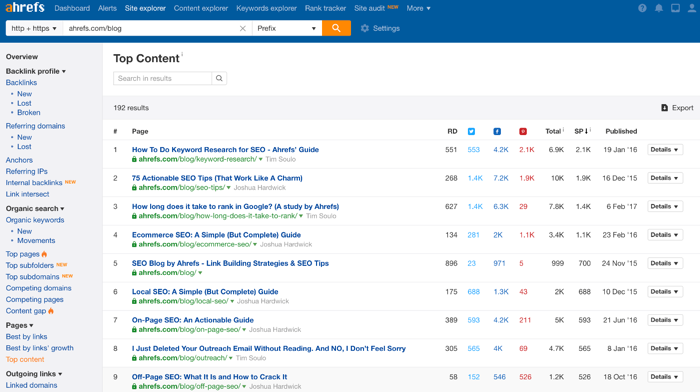
Since they’ve proven themselves on social media, these posts are the most likely to resonate with audiences beyond your blog’s existing one.
Editor’s Note:
Though they aren’t nearly as detailed, there are a few free tools to track social media shares if you aren’t an Ahrefs customer.
As an example, SharedCount.com lets you copy and paste URLs of individual posts; however, they only show counts for Facebook and Pinterest:
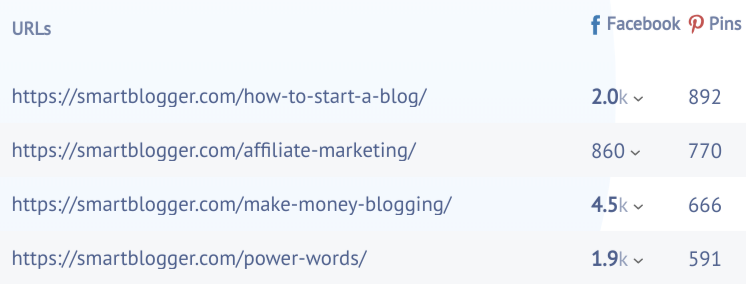
Step #2. Import Your Post Into Medium
Enter the URL of your post into the Medium import tool and hit “Import”.
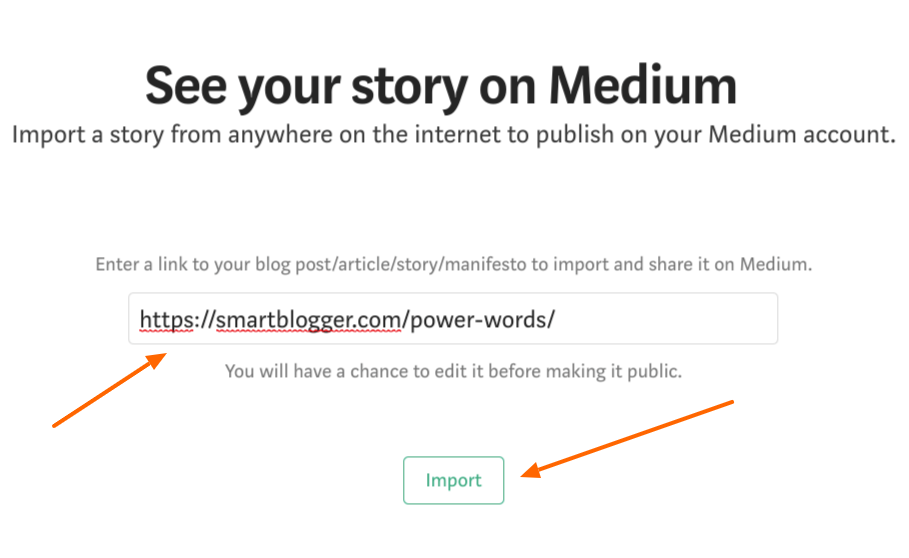
Step #3. Publish Your Post on Medium
Follow Medium’s guidelines to format and polish your post, then click “Publish”.
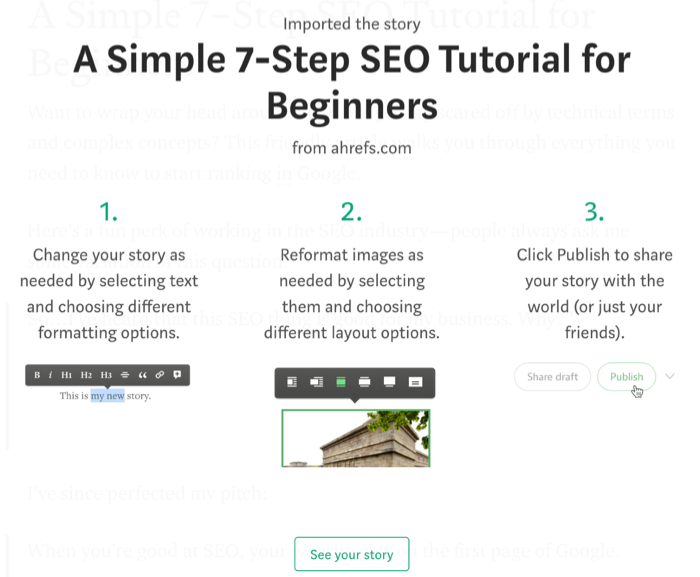
That’s all there is to it!
#3. Smart Social Sharing
I know, I know.
It’s 2019, and promoting your blog posts on social media is by no means a new strategy.
BUT — there’s more to social media promotion than pasting a link and clicking a “Tweet” button.
Here’s an example of the success we’ve seen from smart sharing on the Ahrefs Twitter account:
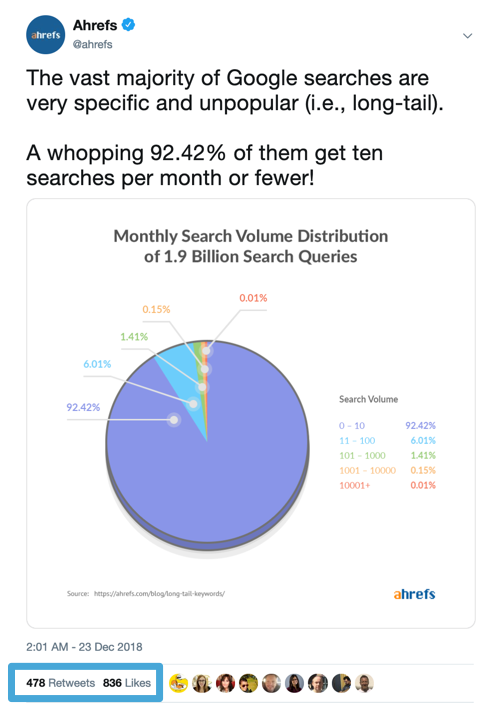
Pretty impressive, right?
Here’s another example:
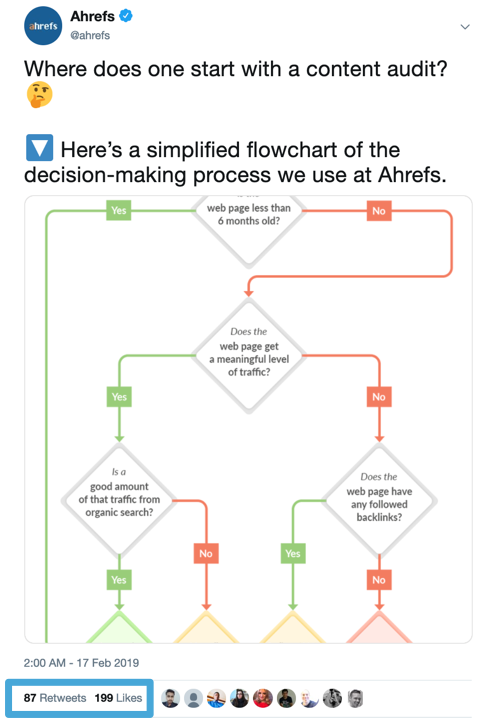
These tweets received amazing engagement, but we actually spent very little time creating them.
We achieved this ROI by working smarter, not harder.
How to Promote Your Blog Using Social Media (Smartly)
Here’s our process:
Step #1. Brainstorm Ideas and Organize Them
The great thing about social media content is it’s all fleeting. Even if an idea is a flop, it’s easy to turn the page and try the next idea.
But to make the most of these (admittedly fleeting) opportunities, you need two things:
- A large list of ideas;
- A method for grouping similar ideas into categories.
To brainstorm ideas, get a pen and paper (or launch Google Docs, Microsoft Word, etc.) and jot down things you would like to try.
Get as creative as you want.
Think memes would be popular with your audience? Write it down. Believe infographics or inspirational quotes could be successful? Write them down. Believe posts or tweets on Topic X or Topic Y could receive high engagement?
(You get the idea.)
By listing all of your ideas, you’ll then be able to group them into categories. This will help you track which categories are successful and which are not.
Step #2. Craft and Publish (and Monitor) Your Content
You can use social media management tools like Buffer and MeetEdgar to schedule your content and keep it running automatically.
Once your social media posts begin making their way into the wild, you’ll be able to track their progress.
Do some receive more comments, while others receive more shares and retweets? Are some more popular in the mornings, while others receive more engagement during the evenings?
All data, both good and bad, will help you in the next step.
Step #3. Review the Results
After an appropriate amount of time has gone by, hold a review.
Drop the categories that didn’t perform well. Keep the ones with potential and refine them.
You want to focus on the categories your audience likes and tweak them.
Do they like emojis, or do they gravitate towards a more “serious” tone? Do they like infographics, or long chunks of copy with statistics thrown in?
And so on.
From here, keep repeating steps 1-3 until you’ve locked down the type of content your audience loves.
And once you’ve figured out what they love, keep giving it to them.
Step #4. Advertising (Optional)
If you want to try advertising, the above process will save you some serious money.
Pick your top organic performers from Step #3 and put money into promoting them.
Since they’ve already proven themselves to be popular, this is a safe and effective way to buy ads to promote your blog (without wasting time and money on losers).
#4. Create Roundup Posts
The perks of this strategy pretty much sell themselves.
Here’s what happens when you publish a good roundup post:
- First off, it’s easy to write since most of the content is created for you;
- You make new and powerful connections within your industry;
- Thanks to those connections, you gain access to new audiences;
- Your post naturally gains backlinks and social shares.
So… what’s a roundup post, anyway?
Here’s an example:

Essentially, a roundup post features a compilation of answers to a single question, ideally by established experts in the field.
A great roundup post adds immense value to readers since they offer a range of expert opinions in one place.
Plus, they tend to bring in lots of traffic since the experts featured in them will often share the post with their own audiences.
What’s not to love?
How to Create Roundup Posts
Here are the basics of roundup posts so you can create your own:
Step #1. Craft Your Question
Don’t take this step lightly.
If you ask too much of the experts you’ll be polling, most won’t have time to participate (even if they want to). And if you ask a question they’ve heard (and answered) a million times, most won’t be interested.
Your question needs to be clear, succinct, and something that will appeal both to your readers and the experts you’ll be asking to participate.
Step #2. Create a List of Influencers
Once you’ve crafted your question, it’s time to create your influencer wish list. These are the influencers (“experts”) you’ll be asking to participate in your roundup post.
Since not everyone will respond to you, reach out to significantly more experts than you need.
For example, if you need 20 people for your roundup post, reach out to 40 experts (or more).
Remember:
A roundup post is only as good as the people you feature. While it takes exponentially more time and effort to get a response from a more recognized name in your industry, it’s likely worth it.
With that said, don’t expect the Michael Jordans of your industry to respond to your outreach — try to find people with a reasonable level of influence who aren’t complete titans.
Step #3. Reach Out to the Experts
You can use specialized tools like BuzzStream or Mailshake to streamline the entire outreach process by making it easier to hunt down email addresses, batch send messages, and conduct follow-ups.
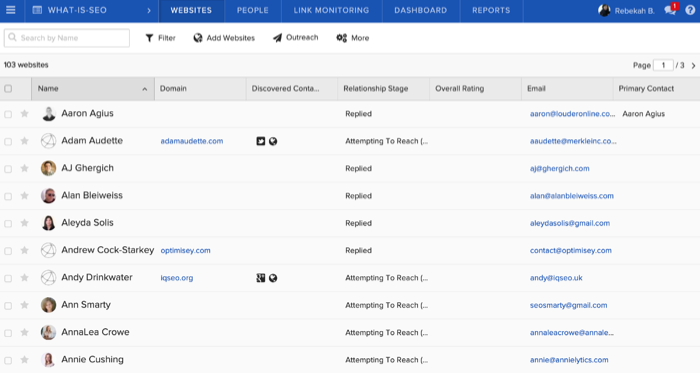
Quick tips for the message you send:
- Keep it short;
- Keep it genuine.
Step #4. Follow Up (But Only Once)
There’s a chance your first email will slip past the expert you’re trying to reach. After all, they’re very busy and likely receive dozens (or hundreds) of emails every single day.
This is why sending a follow-up email is helpful:
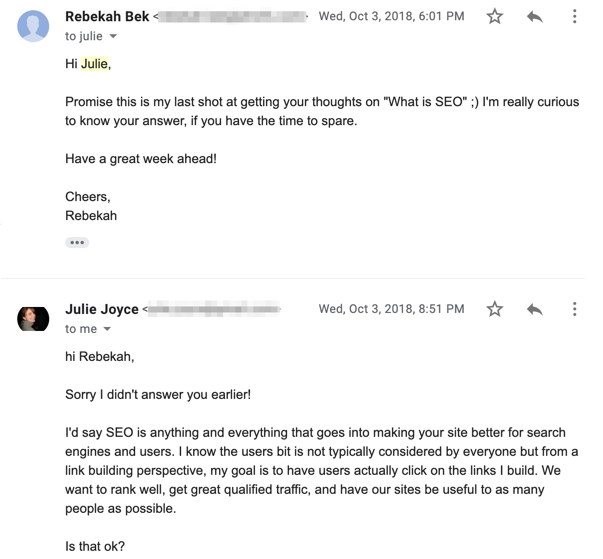
However, please don’t follow-up more than once — any more than that and you’re just being a nuisance.
Step #5. Compile Your Responses
At this point, you’ll have a bunch of answers ready to sift through. Now all you need to do is turn them into a cohesive post.
Try to find trends in the responses and sort them into sections.
Next, add your own introduction to each section, as well as your opinion on why certain trends occurred.
This is how you put your stamp on the roundup post and make it your own.
Step #6. Publish Your Post (And Tell the Experts)
Once your post is published, it’s time to let everyone know about it.
Email everyone who responded to your outreach emails (whether they ultimately contributed to your post or not) and thank them for their time. Include a link to your post, and be sure to send them well-wishes.
You can also ask them (politely) to share your post with their audience, but this is often implied.
Editor’s Note:
Want to let influencers know your post has been published and promote the post at the same time? In addition to emailing them, tag the influencers on Twitter too.

#5. Advocate In-Person
While all blogs are digital in nature, your promotional efforts aren’t limited to the digital world alone.
It might be a step (or ten!) outside your comfort zone, but try this:
Approach a local event in your niche and pitch yourself as a speaker.
It doesn’t matter where you are in the world or how big the event is — it could even be a small meet-up session.
The idea is to reach out to new people and give the work you do a huge visibility boost.

How to Promote Your Blog by Speaking at Events
If you’re interested in this advanced promotional tactic, here’s how to get started:
Step #1. Shortlist a Few Events or Meet-Ups You’d Like to Attend
If you’re not sure where to start, look around on Reddit, Facebook groups, or Slack groups and join some communities in your industry.
Chances are good people are organizing and promoting events in these communities.
Make a list of potential targets, underline your favorites, and move on to the next step.
Step #2. Pitch Yourself to Event Organizers
When pitching yourself, propose some topics that you’d be comfortable speaking about and explain how your content will add value to their audience.
Hopefully it goes without saying, but you should know these topics very well.
Step #3. Craft Your Presentation
Try to deliver as much value as you can and position your blog as a great resource. This is also a good time to promote your social media accounts, which are ideally already geared towards driving traffic to your blog.
Just be sure not to make it all about you. Your job is to teach, to impart your know-how to others.
And when you’re able to do this well, promoting your blog will happen organically.
Step #4. Speak
Show up to the event, deliver your speech, meet lots of new people, and enjoy converting some new readers!
Editor’s Note:
To improve your chances of landing speaking engagements, make sure you:
- Have a website (aka your business card);
- Create a 2-3 minute demo video (aka your movie trailer);
- Acquire a few testimonials (from people willing to vouch for you).
There’s a lot more to it than we can unpack here, so be sure to check out Grant Baldwin’s post How to Get Speaking Engagements. In fact, browse his entire website, The Speaker Lab. It’s chock-full of helpful information.
#6. Integrate Your Blog with Your Product
Most businesses have blogs that are completely disconnected from their main product.
If you blog for a brand or business, why not align your messaging and integrate your blog posts directly into your UI (for software products) or in your product descriptions and previews (for e-commerce)?
This lets you direct traffic over to your blog and gives your customers a more seamless experience.
How to Fuse Your Blog and Product
For software products, one way to notify people of your newest blog posts is to include a (preferably unobtrusive) in-app notification.
Here’s what it looks like when using Ahrefs:
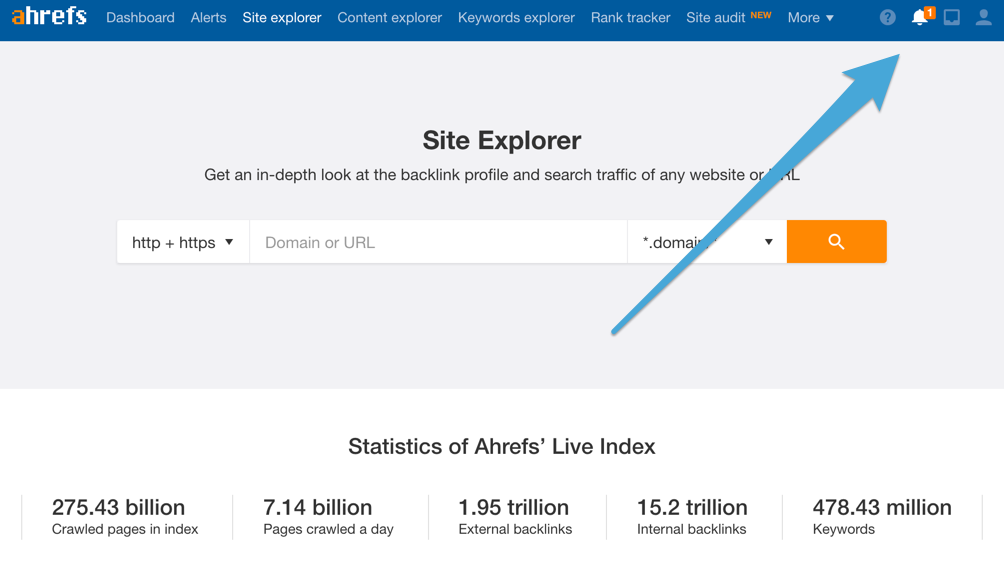
Click the bell icon and we display a simple drop-down menu listing all our newest content.
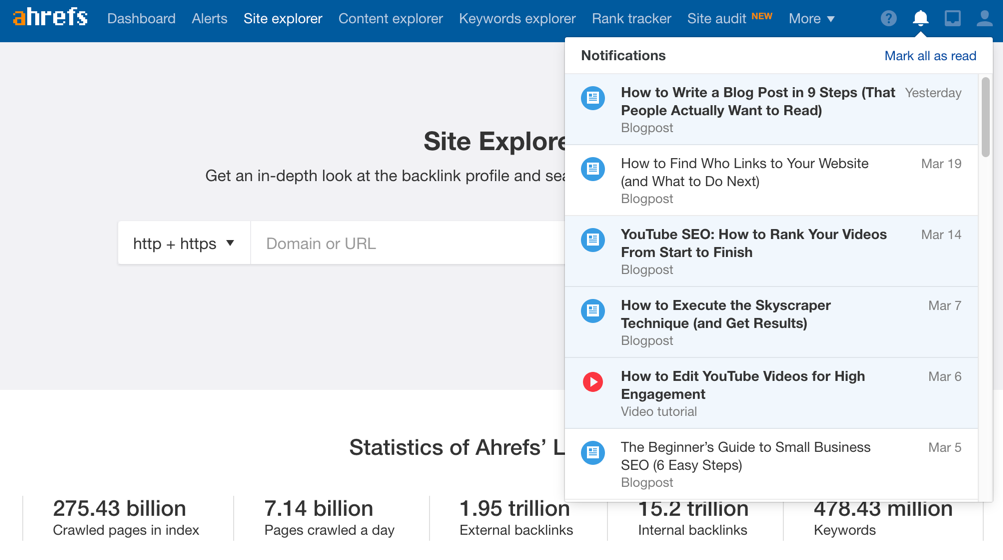
So simple, but so effective.
If you have an e-commerce website and your blog posts are educational in nature, you can promote them directly on your homepage.
Beardbrand does this beautifully:
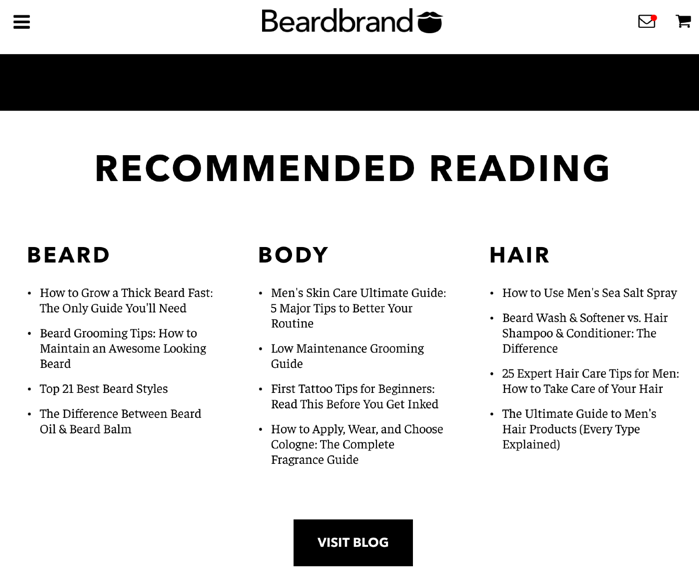
Another way to do this is by scattering in individual links and excerpts of your blog posts wherever they’re relevant. This is how Mr Porter does it:

Time to get creative!
Editor’s Note:
Here’s one more tip that’s missed by a surprising number of business websites…
Include a prominent link to your blog in your website’s navigation menu.
Ahrefs, MeetEdgar, Elegant Themes (affiliate link), and many other smart businesses feature their blogs in their navigation, which helps drive traffic to them.
Here’s how Quuu (affiliate link) does it:

In other words:
If people have to hunt to find your blog ON YOUR OWN WEBSITE, you're doing it wrong.Click To Tweet#7. Collaborate with Other Blogs
Creating content in collaboration with another blog means you’re able to tap into each other’s audiences and can promote yourself to a whole new set of blog readers.
You can even split the work!
Here’s a post that Ahrefs did with Buffer, a social media management tool:
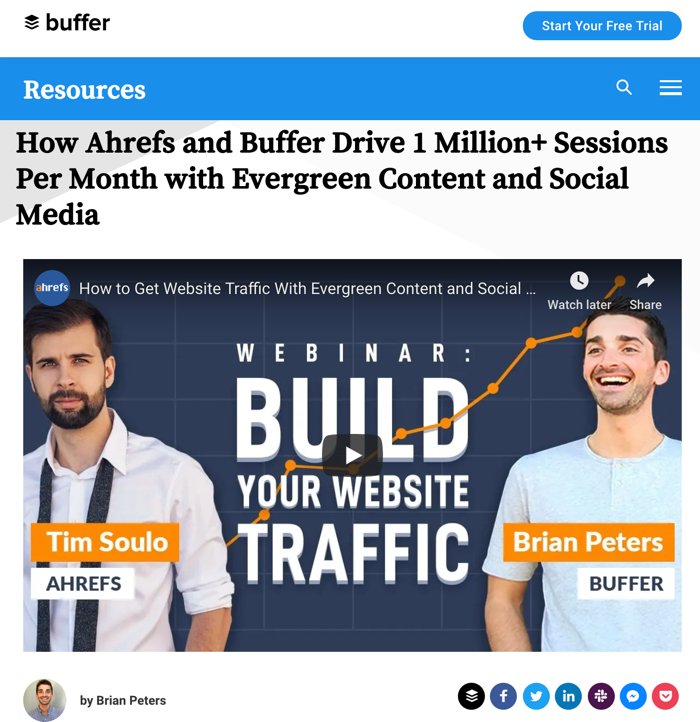
How to Join Forces With Another Blog
Fair warning:
Collaborating with blogs significantly larger than yours probably isn’t in the cards. However, collaborating with a site similar in size is definitely doable.
Here’s how to get started:
Step #1. Find Opportunities in Your Niche
Look for opportunities to work with blogs within the same niche as yours.
Start by approaching bloggers you have an existing relationship with and ask if they’d like to collaborate. You should leave cold pitching as a last resort.
If you have no idea which blogs to approach, Ahrefs offers a nifty trick:
In Content Explorer, enter a relevant keyword phrase in your niche.
Set the “published” filter to “Last 12 months” and the “Language” filter to “English”. Next, highlight the “one link per domain” option.
Finally, you’ll want to set one more filter: DR (“domain rating”).
The higher this number, the more authoritative the website; however, the more authoritative the website the harder it will be for you to get the blogger’s attention.
In the screenshot below, we set the DR to 40:
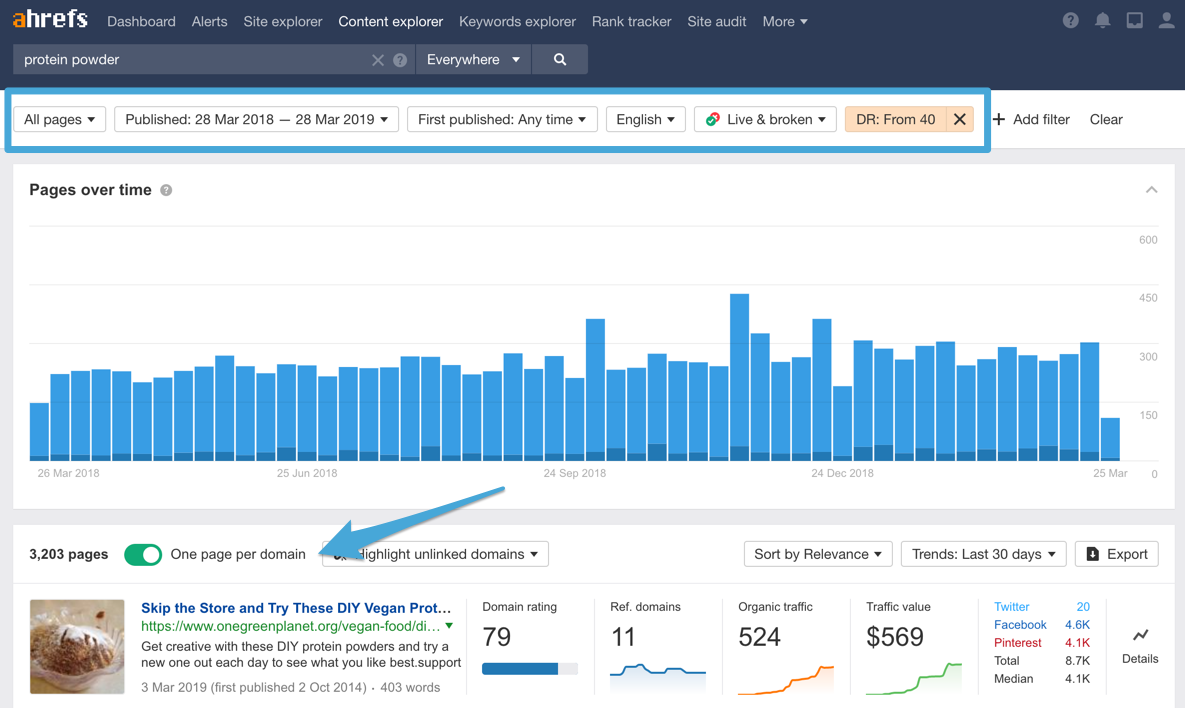
This will pull a list of active blogs in your niche.
From here, just sift through the possibilities and pick the ones you’d like to approach.
Step #2. Make Your Pitch
The process is pretty similar to advocating in-person: you need to make your best pitch.
Focus on explaining why you want to work with that particular blogger, as well as how collaboration will benefit them.
Feel free to suggest a couple of topics you feel would work well.
Step #3. Create
Creation time!
Finalize your content with the blogger you’re working with and remember to stay prompt and gracious throughout.
This is not the time to get pushy or rude and make an enemy out of a would-be ally.
Step #4. Publish and Promote
Promote the post to your newsletter and social media accounts. Make sure to tag and give credit to the other blogger too.
#8. Repurpose Content Into Other Formats to Reach New Audiences
You’ve spent all this time and effort to create amazing content in the form of blog posts.
Why not get more out of the same piece of content?
Since your customers hang out in multiple places online and have their own preferences when it comes to content formats, you should try to reach audiences beyond blog readers.
And you do that by repurposing your content.

How to Repurpose Your Content
Some examples:
- Turn your blog posts into SlideShare presentations;
- Take a small section of your blog post and reimagine it as an infographic;
- Convert your blog post into a YouTube video.
Or, do it in reverse.
We published a YouTube tutorial on WordPress SEO. It has over 20,000 views and 70 comments — not too shabby.
We decided to turn it into a blog post. Here’s how it performed:
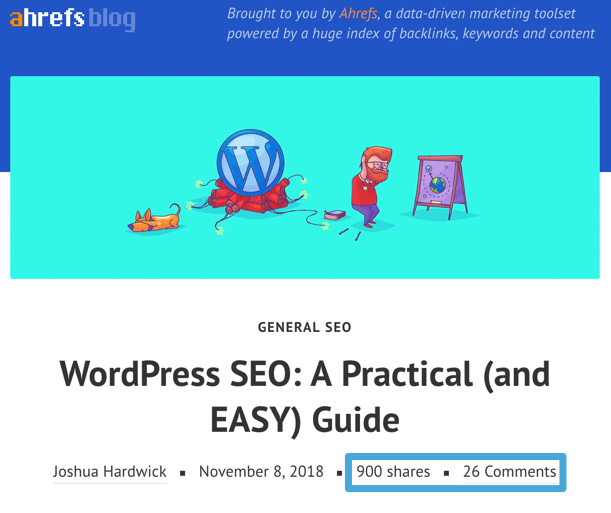
By re-creating our video in written form, we were able to reach an entirely new audience on an entirely different platform.
And the best part?
We didn’t have to come up with fresh content for the post. We took what we already had and created something new with it.
#9. Monitor Online Conversations for Opportunities to Promote Yourself
People talk about all sorts of things on the Internet, including your niche.
If you monitor these conversations, you’ll get lots of chances to slide into the discussion, add value, and (subtly) promote your blog.
Here’s a pretty meta example of this tactic in action.
I once mentioned Talkwalker alerts in a blog post I wrote, and an employee commented on the post to provide the link:
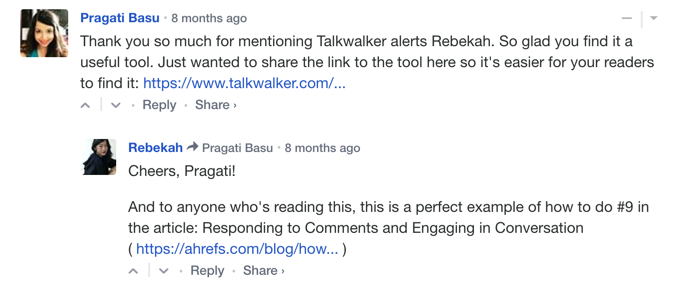
How to Monitor Conversations for Promotion Opportunities
Tracking online conversations is surprisingly easy. Here’s how you do it:
Step #1. Set up Your Alert
You can use a free tool like Google Alerts, or services like Talkwalker Alerts and Ahrefs Alerts.
For Ahrefs, go to Alerts, Mentions, +New Alert, and enter your keyword you’d like to track.
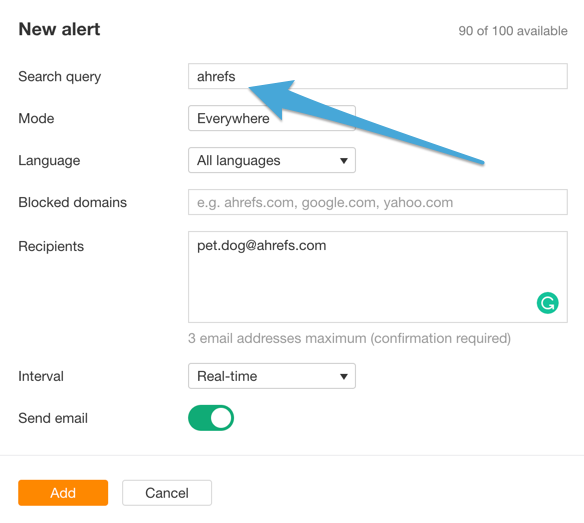
What these tools do is send you an email every time a keyword is mentioned on the web.
From there, you can simply follow the link in the email to find out where you’ve been mentioned.
Step #2. Carefully Monitor Your Mentions
Whether your mention comes in a blog article or a forum discussion, look for suitable areas where you can add value.
For example, if you’re a food blogger and you receive an alert for a discussion of a restaurant, it’s your time to shine by talking about your own experience.
However, a word of warning:
It’s extremely important not to shoehorn yourself into conversations.
If you’re clearly only there to advertise your own blog, people will catch on pretty quickly.
So, be sure to link to your own blog strategically, and only after you’d added value to the discussion.
Editor’s Note:
You can also track mentions using Twitter’s advanced search.
For example, let’s say I wanted to find every English-speaking tweet in 2018 that mentioned Jon Morrow by name:
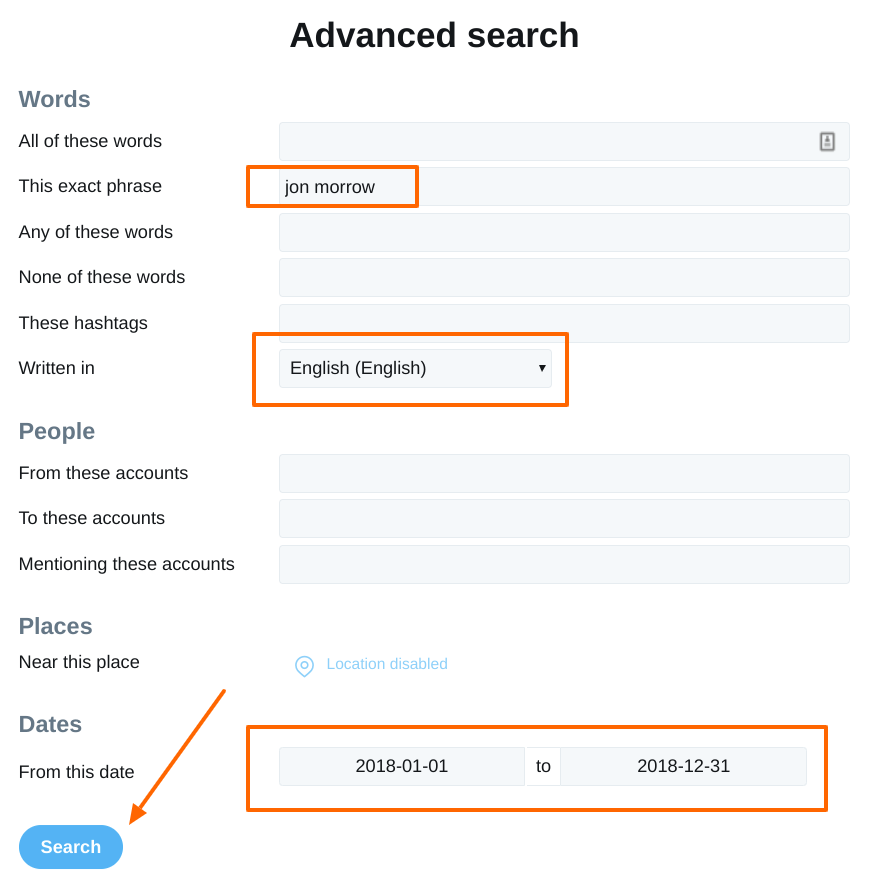
Twitter’s advanced search results would return a veritable smorgasbord of tweets:
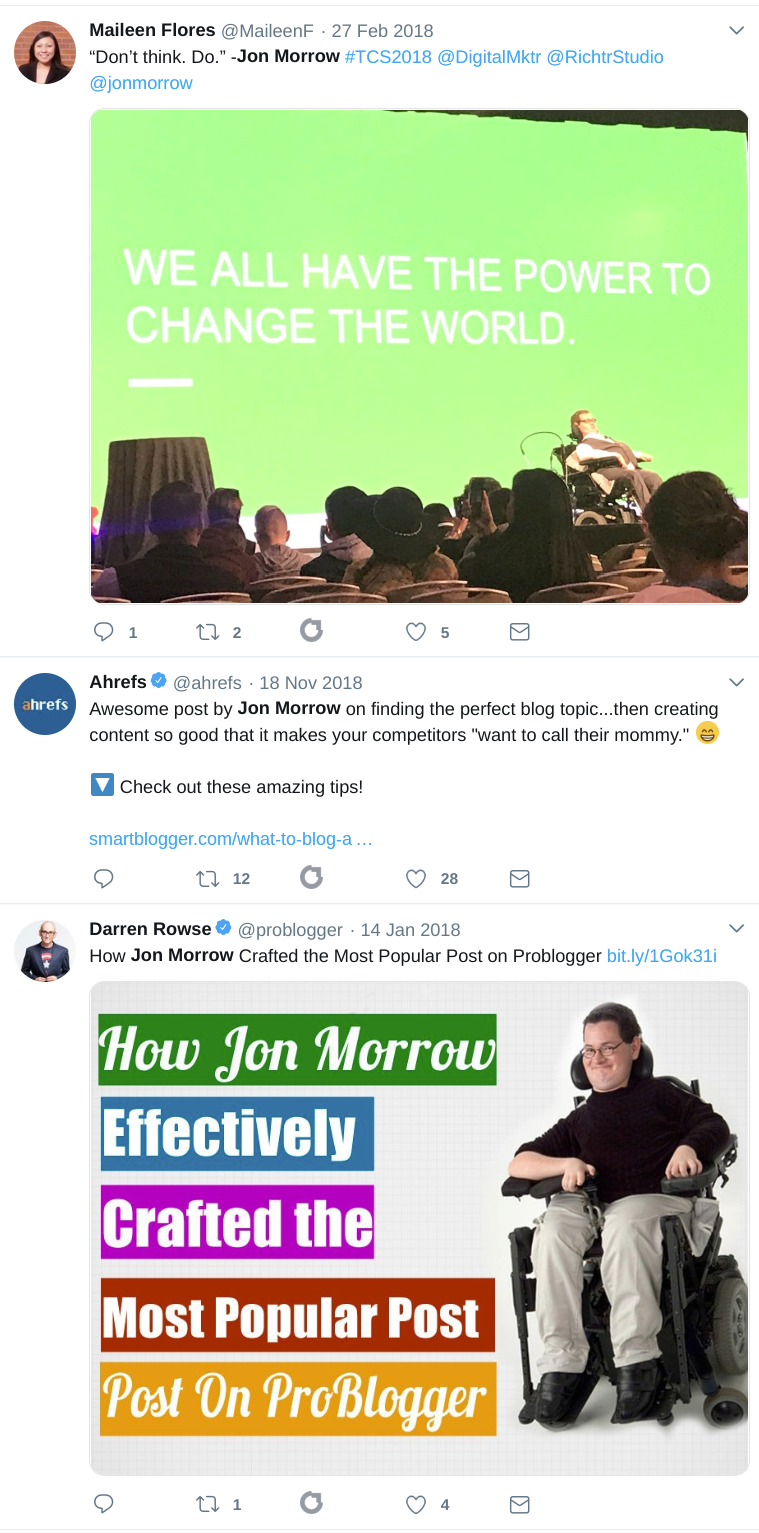
Cool, right?
Use this feature to find keywords and mentions that matter to you, roll up your sleeves, and then get to work. The applications are nearly limitless.
Over to You
If you sometimes find yourself lying in bed at night wondering, “how do I increase my blog traffic?”, I feel your pain.
I did my best to stay away from the more common methods of blog promotion, so hopefully you found something new to try.
Of course, not all of the tactics we discussed will be suitable for, or will work for, your blog and your particular niche.
You’ll need to experiment and find what works for you.
When it comes down to it, marketing is always about experimenting — experimenting, failing, and going at it again and again until you succeed.
Now, go forth and get that traffic!
The post How to Promote Your Blog in 2019: 9 Creative Strategies appeared first on Smart Blogger.
from
https://smartblogger.com/how-to-promote-your-blog/




